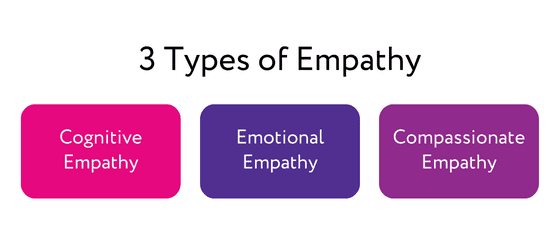What’s the difference between empathy and sympathy?
While the terms are often used interchangeably, they are distinct concepts that play significant roles in our personal and professional lives. As a leader, understanding the nuances between empathy and sympathy can significantly impact your leadership approach and cultivate a more harmonious and supportive work environment.
One enables you to connect with people on a deeper level and make the other person feel heard. And it’s not just about the technical differences; the application of empathy can produce dramatically different results to sympathy.
In this article, we will delve into the differences between empathy and sympathy, explore the three types of empathy, and discuss how you can use this skill to improve your leadership capability.
The Meaning of Empathy vs Sympathy
Sympathy: Sharing Concern
Sympathy is a feeling of sincere concern for the other person’s problems or misfortunes. Although there is a degree of caring, with sympathy, there is an emotional distance. This is because a sympathetic approach comes from your perspective rather than the other person’s perspective.
Sympathy demonstrates a surface-level understanding of someone else’s situation without diving deeper into their feelings. Another way to think about sympathy is like standing on the shore, watching someone navigate choppy waters from a distance.
Empathy: Stepping into Another’s Shoes
Empathy is the ability to understand and share another person’s feelings. It means understanding what another person is going through by taking their perspective. It involves understanding and connecting with someone’s emotions. You essentially enter their world and feel what they are feeling.
It requires you to put yourself in their shoes and genuinely experience what they are going through. Empathy is like diving into the ocean and swimming alongside the person, feeling the waves crash against your skin.
The Differences Between Empathy and Sympathy
Empathy is a skill that fosters connection and demonstrates respect, and it brings people together and promotes inclusivity. In contrast, sympathy can inadvertently create an imbalanced power dynamic, leading to isolation and disconnection. It’s an unfortunate outcome, given that sympathy usually comes from a good place.
One critical difference between sympathy and empathy lies in the level of involvement. Sympathy is having thoughts about what someone else is feeling; empathy actively requires you to put yourself in the other person’s position and experience their emotions first-hand. It requires active engagement, while sympathy is often more passive.
Empathy and sympathy are both rooted in compassion, but their underlying dynamics set them apart. Sympathy involves keeping an emotional distance, whereas empathy goes a step further and enables you to connect on a deeper level.
For leaders, using an empathetic approach necessitates stepping into the shoes of their employees, comprehending their experiences, and effectively articulating their feelings. This requires emotional intelligence, particularly self-awareness – qualities that not all leaders possess; conversely, sympathy can be expressed through simple gestures of regret or sadness for the other person’s situation.
Understanding these crucial differences between empathy and sympathy is key to becoming a more effective and compassionate leader. Developing an empathetic leadership style can help you establish meaningful connections, foster a supportive work environment and promote the well-being and success of your team.

The Three Types of Empathy
Empathy comes in various forms, each encompassing different aspects of our emotional intelligence. Understanding these types can help you develop a more comprehensive approach to empathetic communication.
Cognitive Empathy – Understanding Perspectives
Cognitive empathy, also known as perspective-taking, involves grasping and comprehending another person’s point of view. It requires active listening, open-mindedness, and the ability to put aside personal biases. Cognitive empathy allows you to intellectually understand someone’s emotions without necessarily experiencing them yourself.
Emotional Empathy – Sharing Emotions
Emotional empathy involves experiencing and sharing the emotions of others. It enables you to feel what another person feels, creating a profound emotional connection. Emotional empathy requires paying attention to non-verbal cues, facial expressions, and body language. It allows you to genuinely connect with others on an emotional level.
Compassionate Empathy – Taking Action
Compassionate empathy combines cognitive and emotional empathy with a desire to take action and help those in need. It involves understanding and sharing emotions and actively seeking ways to alleviate suffering and provide support. Compassionate empathy motivates you to make a positive difference in the lives of others.
Empathy in Leadership
Empathy is a vital component of effective leadership because it allows leaders to connect with their employees on a deeper level. By understanding their employees’ feelings, leaders can gain insights into their motivations, needs, and perspectives. This allows them to build stronger relationships, communicate more effectively, and resolve conflicts more effectively. Empathy is also crucial for developing trust and a healthy workplace culture.
On the other hand, sympathy is a less valuable trait in leadership. While it may be appropriate to show sympathy in certain situations, such as when an employee is grieving the loss of a loved one, it can also create a sense of distance between the leader and their employees. When leaders only show sympathy, they are not truly connecting with their employees but merely acknowledging that they are going through a tough time.
Leaders who are skilled in empathy are better equipped to build strong relationships with their employees, foster a positive work environment, and improve overall job satisfaction. When employees feel heard and understood, they are more likely to be motivated and engaged. This can lead to increased productivity and improved results for the organisation.
In addition to empathy, leaders also need to possess other essential traits, such as emotional intelligence, self-awareness, and the ability to communicate effectively. These traits can be developed through training, coaching, and self-reflection. Leaders who are committed to personal and professional growth can significantly benefit from learning how to apply empathy and other important traits in their leadership style.
The Benefits of Demonstrating Empathy as a Leader
As a manager and leader, empathy is vital to strengthen your leadership skills and foster a positive work environment. Here are some ways empathy can be leveraged in leadership:
Building Trust and Rapport
By demonstrating empathy, you create an atmosphere of trust and rapport among your team members. When employees feel heard and valued, they are more likely to openly share their concerns, challenges, and ideas. This open communication builds stronger relationships and enhances collaboration within the team.
Effective Conflict Resolution
Empathy plays a crucial role in resolving conflicts constructively. By empathetically understanding the perspectives of all parties involved, you can facilitate a more balanced and empathetic approach to conflict resolution. This enables you to find win-win solutions and maintain positive relationships.
Enhancing Employee Engagement
When leaders show empathy, they cultivate a sense of belonging and psychological safety within the team. Employees feel comfortable expressing their authentic selves and are more engaged in their work. Empathy helps leaders identify and address potential issues before they escalate, leading to higher employee satisfaction and productivity.
Nurturing Personal Growth
Empathy allows leaders to support their team members’ personal growth and development. By understanding their individual strengths, challenges, and aspirations, leaders can provide tailored guidance, coaching, and opportunities to facilitate growth. This fosters a culture of continuous learning and motivates employees to reach their full potential.

Employees Want Empathy: The Evidence
Forbes outlined the shift towards employee-led working environments in 2022. Employees hold a leader in much higher regard when they support them and are empathetic towards their employee’s personal situations. Employees view an empathetic leader as someone they can discuss issues with openly and feel empathy creates a more solid and safe working environment for all.
Whereas, if a leader was to communicate with sympathy, this might cause a divide between employee and employer, as mentioned above, it can be seen as condescending.
Expressing Empathy
Many managers and leaders I work with say they want to be more empathic, yet when we unpack the subject, it’s clear that they often empathise with their team members. But they struggle with expressing that empathy – in particular, not coming across as merely being sympathy or, worse, pitying them.
When someone responds sympathetically, this may come across as condescending to another person, as sympathy and pity are often interlinked. Sympathy and pity both describe feeling sorry for someone else’s situation. When pitying someone, it can imply a level of judgement or disapproval towards them rather than supporting them and taking their feelings as your own.
Expressing empathy comes down to communication. What we say, how we say it and how we use non-verbal cues such as facial expressions and body language. The one that managers often find the most difficult is knowing what to say. That’s why I’ve created a free guide with 30 statements and phrases you can keep in your back pocket to help you navigate those difficult conversations and demonstrate empathy.
Download your guide here – Unlocking the Magic of Empathy: 30 power-packed empathy statements to easily navigate challenging conversations.
Empathy vs Sympathy: In Summary
As you can see, empathy and sympathy are two distinct qualities that can significantly impact leadership. Empathy is essential for building strong relationships, communicating effectively, and improving job satisfaction, while sympathy is less valuable in a leadership context.
Leaders who are committed to personal and professional growth can benefit greatly from developing their skills in empathy and other important traits, such as emotional intelligence, self-awareness, and effective communication.
By embracing the three types of empathy and integrating them into your leadership approach, you can build trust, resolve conflicts effectively, enhance employee engagement, and nurture personal growth within your team. So, strive to be an empathetic leader who empowers and uplifts others, paving the way for success and harmony in the workplace.
Downloading our free guide on empathetic language will enable you to take the first step to developing your empathy skills. If you’d like to learn more about empathy, get in touch to discuss our online course, The Art of Empathy: Your Journey to Becoming a More Empathetic and Influential Leader.
Author: Gemma Rolstone | Published 6th June 2023.




